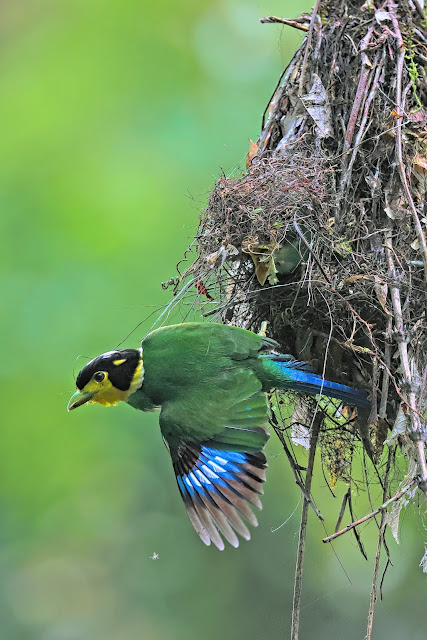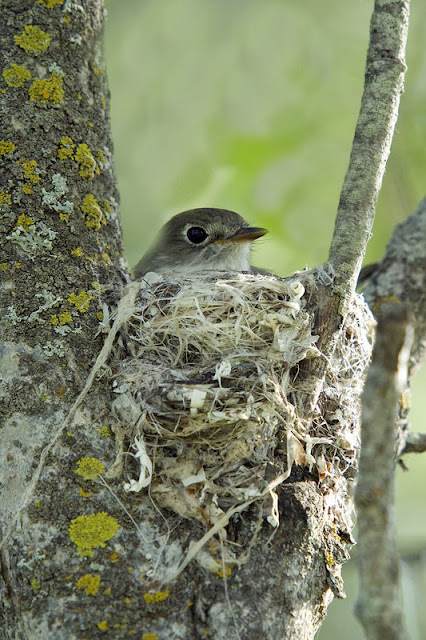Humans have analyzed spider's webs to understand why it is five times stronger than steel while being 1000 times thinner than a human hair. Each strand is made up of thousands of nano strands to attain this remarkable strength. Spider silk has been likened to the man-made Kevlar which is used to make bullet-proof vests.
Some bird species are intelligent enough to utilize this strength in nest building.
Locally, in Malaysia, with over 20 years in the field I have observed several species of broadbill utilizing web strands as well as the Common Iora, that has also been documented previously by a Singapore group. In the Americas; Hummingbirds, Kinglets, Gnatcatchers and Vireos have also been observed to embrace the same mode of structural engineering.
Broadbills in Malaysia are birds of the forest that are not commonly seen during the non-breeding season but build loose pendulous nests near rivers, streams, or forest tracks during the nesting season. In Khao Yai national park in Thailand there are many Long-tailed Broadbill nests hanging from telegraph/power lines that are adjacent to paved roads through the park. Waterways or roads are thought to provide easier access to the nest during the frenetic breeding season.
I have observed Black and Red, Long-tailed and Silver-breasted Broadbills to draw the following conclusions. I have not observed Long-tailed Broadbills in the process of building their nests but have seen many nests and spider thread can be seen interwoven in all of them.A pair of Black and Red broadbills were photographed building a nest near the Kinabatangan River in Sabah. The following images detail how the pair tease the web apart and then apply it to the outside of the rather loose nest, often entailing picking up the thread and spiraling around the nest to place it judiciously.
 |
| Black and Red Broadbill pair |
 |
| Bringing in the Spider's web |
 |
| Applying the spider silk |
 |
| Spiraling around the nest with the spider silk |
 |
| Applying the Spider silk while flying |
 |
| There was a constant flow of material arriving at the nest under construction |
Similarly, Silver-breasted Broadbills were photographed nesting at Fraser's Hill and Bukit Tinggi in successive years. They were in an earlier stage of nest-building and seemed to gather some of the materials including spider web before construction started in earnest.
 |
| A pair of Silver-breasted Broadbills (the female has the necklace) |
The materials were brought in and added constantly to the nest under construction.
 |
| The early phase of the nest building |
 |
| More building material arrives |
The spider's web was brought in, teased out and applied in a spiral motions around the nest's exterior. This seemed to be an earlier stage of the nest construction.
 |
| The spider silk arrives |
 |
| It is teased out to single threads |
 |
| The silk is applied around the nest |
 |
| Another Silver-breasted Broadbill nest, with spider silk apparent, and three chicks within |
At Fraser's Hill I also photographed a Long-tailed Broadbill pair nesting. The three chicks in the nest were about to fledge. Spider silk was apparent interwoven in the plant material of the nest.
 |
| Long-tailed Broadbill |
 |
| Common Iora with a chick in the nest |
The use of Spider's silk to strengthen nests by various bird species is not confined to Malaysian species. Various relatively small species in the Americas have been recorded to re-purpose this fantastic strengthening material. Picture below are examples of some of these species. The spider's silk is apparent on each of these nests.
Nesting Material and Nest Building Technique in Two Species of Broadbill (Cymbirhynchus macorhynchos) and Corydon sumatranus, Passififormes, Eurylaimidae) from South Vietnam. E.N. Zubkova Biology Bulletin Vol 44, No 7, pp769-786.

































Comments
Post a Comment